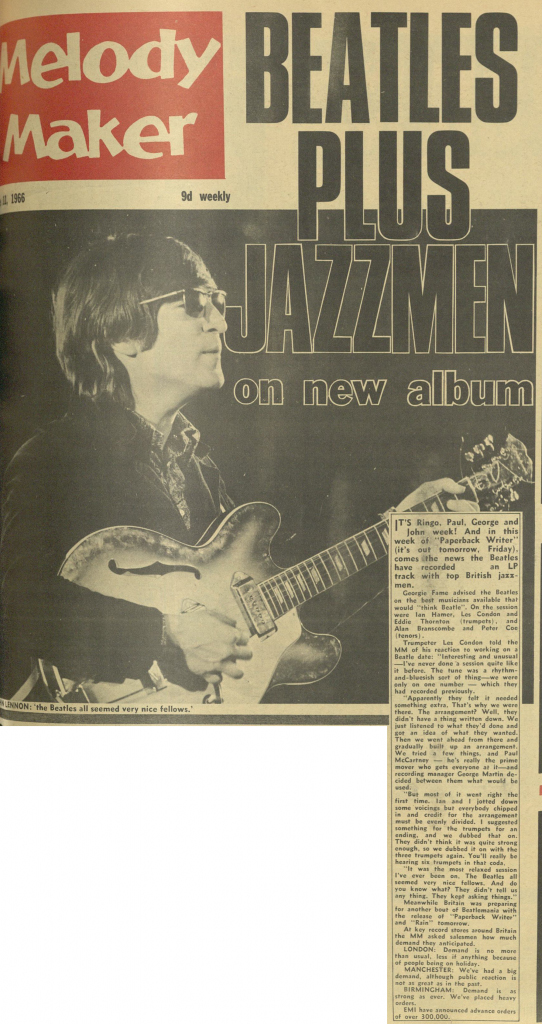From Peter Coe Songs, Albums, Reviews, Bio & More | AllMusic:
As a member of Georgie Fame’s Blue Flames, Peter Coe contributed the intense tenor saxophone solo so integral to the group’s chart-topping British smash “Yeh Yeh.” Two years later, he achieved international immortality as a member of the brass section that buoys the Beatles’ soul-influenced perennial “Got to Get You into My Life.” Born November 21, 1930, in Cambridge, England, Coe studied illustration at the Cambridge School of Art but also pursued saxophone, honing his skills in a series of local dance bands. […]
Upon returning to London, Coe split his time between graphic design and music until 1963, when he signed on with emerging blue-eyed soul singer Georgie Fame, the former Billy Fury backing pianist who assumed control of his band, the Blue Flames, after Fury sacked the group. A series of minor hits including “Do the Dog,” “Green Onions,” and “Bend a Little” preceded the blockbuster “Yeh Yeh,” previously recorded by Latin jazz giant Mongo Santamaria — Fame’s rendition hit number one in the U.K. in January 1965, breaking the Beatles’ stranglehold on the top spot. Coe resurfaced on Fame’s smash follow-up “Getaway,” and his gritty, impassioned solos — profoundly influenced by the sound and sensibilities of American R&B — are essential to the soulful authenticity of Fame’s finest moments.
In the summer of 1966, Coe entered London’s Abbey Road Studios, joining fellow tenor saxophonist Alan Branscombe and trumpeters Eddie Thornton, Ian Hamer, and Les Condon to contribute the Stax-inspired brass arrangement for the Beatles’ “Got to Get You into My Life,” the penultimate track on the classic LP Revolver. A longtime fan favorite, the song was finally issued as a single in 1976, entering the U.S. Top Ten six years after the Beatles split. By that time, Coe was long since out of popular music — after a yearlong stint as a big-band contractor and director for Polydor Records, he resumed his illustration career in 1970, forming his own design firm. He nevertheless led an occasional jazz quartet in and around London, and his semi-pro orchestra won the BBC big-band championship on three separate occasions. Coe relocated to Spain in 1987, playing for six years at Magnum’s Jazz Bar near Marbella. He died on March 16, 2009, at the age of 78.
Eddie Thornton and Glenn Hughes were members of Georgie Fame and the Blue Flames, a British rhythm and blues group whose repertoire spanned jazz, soul, ska, and calypso, that Paul McCartney and John Lennon had seen live a few times in some London nightclubs. Through this connection, they were invited to the “Got To Get You Into My Life” session in May 1966 by Paul. However, Glenn Hughes fell ill and was replaced at the last minute by Peter Coe, another member of the Blue Flames. Three other freelancers joined them.
Georgie (Fame) called me, so I rushed up to the EMI Studios. Because I play tenor sax it meant having two tenors instead of a tenor and baritone…The Beatles wanted a definite jazz feel. Paul and George Martin were in charge. There was nothing written down but Paul sat at the piano and showed us what he wanted and we played with the rhythm track in our headphones. I remember that we tried it a few times to get the feel right and then John Lennon, who was in the control room, suddenly rushed out, stuck his thumb aloft and shouted ‘Got it!’ George Harrison got a little bit involved too but Ringo sat playing draughts in the corner.
Peter Coe – Trumpet player – From The Complete Beatles Recording Sessions by Mark Lewisohn, 2004
BEATLES PLUS JAZZMEN
IT’S Ringo, Paul, George and John week! And in this week of “Paperback Writer” (it’s out tomorrow, Friday), comes the news the Beatles have recorded an LP track with top British jazzmen.
Georgie Fame advised the Beatles on the best musicians available that would “think Beatle”. On the session were Ian Hamer, Les Condon and Eddie Thornton (trumpets), Alan Branscombe and Peter Coe (tenors).
Trumpeter Les Condon told the MM of his reaction to working on a Beatle date: “Interesting and unusual — I’ve never done a session quite like it before. The tune was a rhythm-and-bluesish sort of thing — we were only on one number which they had recorded previously. Apparently they felt it needed something extra. That’s why we were there. The arrangement? Well, they didn’t have a thing written down. We just listened to what they’d done and got an idea of what they wanted. Then we went ahead from there and gradually built up an arrangement. We tried a few things, and Paul McCartney – he’s really the prime mover who gets everyone at it — and recording manager George Martin decided between them what would be used. But most of it went right the first time. Ian and I jotted down some voicings but everybody chipped in and credit for the arrangement must be evenly divided. I suggested something for the trumpets for an ending, and we dubbed that on. They didn’t think it was quite strong enough, so we dubbed it on with the three trumpets again. You’ll really be hearing six trumpets in that coda. It was the most relaxed session I’ve ever been on. The Beatles all seemed very nice fellows. And do you know what? They didn’t tell us anything. They kept asking things.”
From Melody Maker – June 11, 1966

Recording and mixing "Got to Get You Into My Life"
May 18, 1966 • Songs recorded during this session appear on Revolver (UK Mono)

Notice any inaccuracies on this page? Have additional insights or ideas for new content? Or just want to share your thoughts? We value your feedback! Please use the form below to get in touch with us.